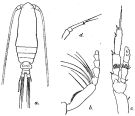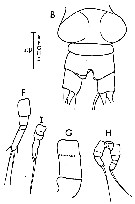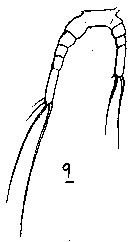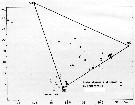|
|
 |
Fiche d'espèce de Copépode |
|
|
Calanoida ( Ordre ) |
|
|
|
Calanoidea ( Superfamille ) |
|
|
|
Paracalanidae ( Famille ) |
|
|
|
Calocalanus ( Genre ) |
|
|
| |
Calocalanus contractus Farran, 1926 (F,M) | |
| | | | | | | Ref.: | | | Farran, 1926 (p.234, Descr.F, figs.F); Sewell, 1929 (p.89, figs.F, Rem.); Rose, 1933 a (p.77, figs.F); Farran, 1936 a (p.83); Farran & Vervoort, 1951 d (n°36, p.3, figs.F); Bernard, 1958 a (p.188, figs.F, ? M) 1960 (n°36, p.4, figs.F,M); Corral Estrada, 1970 (p.119, figs.F,M, Rem.); Razouls, 1972 (p.94, Annexe: p.24, figs.F,M); Corral, 1972 b (n°138, p.4, figs.F,M); Chen & Zhang, 1974 (p.109, figs.F,M); Björnberg & al., 1981 (p.626, figs.F,M); Bradford-Grieve, 1994 (p.53, figs.F,M); Bradford-Grieve & al., 1999 (p.877, 909, figs.F,M); Avancini & al., 2006 (p.68, Pl. 37, figs.F,M, Rem.); Vives & Shmeleva, 2007 (p.927, figs.F,M, Rem.); Blanco-Bercial & al., 2014 (p.6, Rem.: problematical for barcoding) |  issued from : J. Corral Estrada in Tesis Doct., Univ. Madrid, A-129, Sec. Biologicas, 1970. [Lam.30]. Female (from Canarias Is.): 1, habitus (dorsal); 2, distal segments of A1; 3, P1; 4, P2; 5, P3; 6, P4; 7, P5. Male: 8, habitus (dorsal); 9, posterior part cephalothorax and urosome (dorsal); 10, P5.
|
 issued from : R.B.S. Sewell in Mem. Indian Mus., 1929, X. [p.90, Fig.35]. Female (from S India): a, habitus (dorsal); b, Mxp; c, P4; d, P5.
|
 issued from : Q.-c. Chen & S.-z. Zhang in Studia Marina Sinica, 1974, 9. [Pl.5, Figs.55-61]. Female (from South China Sea): 55, habitus (dorsal); 56, abdomen (dorsal); 57, idem (other specimen); 58, P4; 59, P5. Male: 60, habitus (dorsal); 61, P5.
|
 issued from : C. Razouls in Th. Doc. Etat Fac. Sc. Paris VI, 1972, Annexe. [Fig.27, B, F-I]. Female (from Banyuls, G. of Lion): B, urosome (dorsal); F and I, P5 (from two specimens); G, segments 1 and 2 of A1.
|
 issued from : G.P. Farran in Biscayan Plankton collected during a Cruise of H.M.S. 'Research', 1900.- Part XIV. The Copepoda. (Linn. Journ. Zoology, XXXVI, 1926). [p.303, Pl.5, Figs.1-4]. Female: 1-2, habitus (dorsal and lateral, respectively); 3, P5; 4, urosome (dorsal).
|
 Issued from : M. Bernard in Bull. Soc. Zool. France, 1958, 83. [p.190, Fig.10]. Calocalanus contractus Female (from Algiers Bay, Algeria): Urosome (two aspects).
|
 Issued from : M. Bernard in Bull. Soc. Zool. France, 1958, 83. [p.189, Fig.9]. Calocalanus contractus Female: P5. Nota C.R.; probably a P5 male. Length (except setae): 100 µm.
|
 Issued from : M. Bernard in Bull. Soc. Zool. France, 1958, 83. [p.190, Pl III, a]. With doubt. Calocalanus contractus Male (from Algiers Bay, Algeria): habitus. Length: 0.750 mm.
| | | | | Ref. compl.: | | | Sewell, 1948 (p.323, 418, 427, 442, 459, 468, 477); Grice & Hart, 1962 (p.287, 293: Rem.); De Decker, 1964 (p.15, 18, 28); De Decker & Mombeck, 1964 (p.11); Shmeleva, 1965 b (p.1350, lengths-volume -weight relation); Grice & Hulsemann, 1965 (p.223); Mazza, 1966 (p.69); 1967 (p.355: Rem.); Pavlova, 1966 (p.43); Grice & Hulsemann, 1967 (p.14); Fleminger, 1967 a (tabl.1); Delalo, 1968 (p.137); Park, 1970 (p.475); Deevey, 1971 (p.224); Apostolopoulou, 1972 (p.327, 340); Björnberg, 1973 (p.307, 384); Desgouille, 1973 (p.1, 131, Rem.: p.138); Corral Estrada & Pereiro Muñoz, 1974 (tab.I); Deevey & Brooks, 1977 (p.256, tab.2, Station "S"); Carter, 1977 (1978) (p.35); Dessier, 1979 (p.204); Vaissière & Séguin, 1980 (p.23, tab.1); Brenning, 1982 (p.6, spatial distribution, T-S diagram, Rem.); Kovalev & Schmeleva, 1982 (p.83); Vives, 1982 (p.290); De Decker, 1984 (p.315, 333: carte); Scotto di Carlo & al., 1984 (1042); Regner, 1985 (p.11, Rem.: p.25); Jansa, 1985 (p.108, Tabl.I, , II, III, IV, V); Brenning, 1985 a (p.28, Table 2); Greze & al., 1985 (p.7); Comaschi Scaramuzza, 1987 (tab.1); Lozano Soldevilla & al., 1988 (p.57); Oliveira Dias, 1995 (p.147); Shih & Young, 1995 (p.71); Siokou-Frangou, 1997 (tab.1); Hure & Krsinic, 1998 (p.100); Gilabert & Moreno, 1998 (tab.1, 2); Alvarez-Cadena & al., 1998 (tab.3,4); Suarez-Morales & Gasca, 1998 a (p108); Noda & al., 1998 (p.55, Table 3, occurrence); Harvey & al., 1999 (p.1, 49: Appendix 5, in ballast water vessel); Lopez-Salgado & al., 2000 (tab.1); Razouls & al., 2000 (p.343, Appendix); Sautour & al., 2000 (p.531, Table II, abundance); El-Sherif & Aboul Ezz, 2000 (p.61, Table 3: occurrence); Holmes, 2001 (p.38); Vukanic, 2003 (139, tab.1); Hsieh & al., 2004 (p.397, tab.1); Isari & al., 2006 (p.241, tab.II) ; Dias & Araujo, 2006 (p.59, Rem., chart); Valdés & al., 2007 (p.103: tab.1); Dur & al., 2007 (p.197, Table IV); Khelifi-Touhami & al., 2007 (p.327, Table 1); Cabal & al., 2008 (289, Table 1); Morales-Ramirez & Suarez-Morales, 2008 (p.518); Dias & al., 2010 (p.230, Table 1); Mazzocchi & Di Capua, 2010 (p.426); Medellin-Mora & Navas S., 2010 (p.265, Tab. 2); Isari & al., 2011 (p.51, Table 2, abundance vs distribution); Andersen N.G. & al., 2011 (p.71, Fig.3: abundance); Salah S. & al., 2012 (p.155, Tableau 1); Uysal & Shmeleva, 2012 (p.909, Table I); Aubry & al., 2012 (p.125, fig.8 a, interannual variation); Belmonte & al., 2013 (p.222, Table 2, abundance vs. stations); in CalCOFI regional list (MDO, Nov. 2013; M. Ohman, pers. comm.); Tseng & al., 2013 (p.507, seasonal abundance); Terbiyik Kurt & Polat, 2013 (p.1163, Table 2, seasonal distribution); Lidvanov & al., 2013 (p.290, Table 2, % composition); Bonecker & a., 2014 (p.445, Table II: frequency, horizontal & vertical distributions); Pansera & al., 2014 (p.221, Table 2, abundance); Mazzocchi & al., 2014 (p.64, Table 3, 4, 5, spatial & seasonal composition %); Zaafa & al., 2014 (p.67, Table I, occurrence); Dias & al., 2015 (p.483, Table 2, abundance, biomass, production); Zakaria & al., 2016 (p.1, Table 1); Benedetti & al., 2016 (p.159, Table I, fig.1, functional characters); Ben Ltaief & al., 2017 (p.1, Table III, Summer relative abundance); El Arraj & al., 2017 (p.272, table 2, spatial distribution); Marques-Rojas & Zoppi de Roa, 2017 (p.495, Table 1); Benedetti & al., 2018 (p.1, Fig.2: ecological functional group); Belmonte, 2018 (p.273, Table I: Italian zones) | | | | NZ: | 16 | | |
|
Carte de distribution de Calocalanus contractus par zones géographiques
|
| | | | | | | | | | | | | | |  issued from : A.A. Shmeleva in Bull. Inst. Oceanogr., Monaco, 1965, 65 (n°1351). [Table 6: 12 ]. Calocalanus contractus (from South Adriatic). issued from : A.A. Shmeleva in Bull. Inst. Oceanogr., Monaco, 1965, 65 (n°1351). [Table 6: 12 ]. Calocalanus contractus (from South Adriatic).
Dimensions, volume and Weight wet. Means for 50-60 specimens. Volume and weight calculated by geometrical method. Assumed that the specific gravity of the Copepod body is equal to 1, then the volume will correspond to the weight. |
 issued from : U. Brenning in Wiss. Z. Wilhelm-Pieck-Univ. Rostock - 31. Jahrgang 1982. Mat.-nat. wiss. Reihe, 6. [p.5, Fig.7]. issued from : U. Brenning in Wiss. Z. Wilhelm-Pieck-Univ. Rostock - 31. Jahrgang 1982. Mat.-nat. wiss. Reihe, 6. [p.5, Fig.7].
Spatial distribution for Calocalanus contractus, C. styliremis, C. pavo, C. tenuis from 8° S - 26° N; 16°- 20° W. |
 issued from : U. Brenning in Wiss. Z. Wilhelm-Pieck-Univ. Rostock - 31. Jahrgang 1982. Mat.-nat. wiss. Reihe, 6. [p.6, Fig.10]. issued from : U. Brenning in Wiss. Z. Wilhelm-Pieck-Univ. Rostock - 31. Jahrgang 1982. Mat.-nat. wiss. Reihe, 6. [p.6, Fig.10].
T-S diagram for Calocalanus contractus, and C. sryliremis (all copepodid stages) from 8° S - 26° N; 16°- 20° W, and Namibia.
SO: Southern Surface Water (S °/oo: 34,50; T°C: 29,0); ND: Northern Water of the Surface Layer (S °/oo: 37,5; T°C: 21,0); SD: Southern Deep Water of the surface layer (S °/oo: 35,33; T°C: 13,4). See commentary in Temora stylifera and Brenning (1985 a, p.6). |
| | | | Loc: | | | sub-Antarct. (Indian), South Africa (E & W), Congo, Senegal-Mauritania, Morocco-Mauritania, Moroccan coast, Canary Is., off Madeira, Bay of Biscay, Ireland (S & W), Bay of Lübeck (in Falconetti & Seguin, 1977, p.188), Brazil ( Campos Basin, off Vitoria-Cabo de Sao Tomé, off Macaé, off Amazon, Caribbean Colombia, Bahia de Mochima (Venezuela), G. of Mexico, Cuba, Florida, Sargasso Sea, off Bermuda: Station "S" (32°10'N, 64°30'W), Cap Ghir, Ibero-moroccan Bay, off Gironde estuary, off W Tangier, Medit. (M'Diq, Alboran Sea, N Tunisia, Baleares, Banyuls G. of Lion, Marseille, Toulon Harbour, Ligurian Sea, Lake Faro, Tyrrhenian Sea, Strait of Messina, G. of Gabes, Tareanto, Adriatic Sea, Venise, Aegean Sea, Thracian Sea, W Egyptian coast, Iskenderun Bay, Lebanon Basin), Sharm El-Sheikh, Red Sea, Indian, China Seas (East China Sea, South China Sea), Taiwan (S, W, NE), S Japan (Kuchinoerabu Is.), Australia (Great Barrier, Shark Bay), E Pacif. (off Costa Rica) & SW, California, W Costa Rica, Chile | | | | N: | 98 | | | | Lg.: | | | (29) F: 0,566; (34) F: 0,84-0,66; (38) F: 0,78-0,75; (180) F: 0,76-0,68; M: 0,48; (202) F: 0,68-0,78; M: 0,48; (338) F: 0,8-0,6; M: 0,55-0,5; (786) F: 0,74; (1112) F: 0,6-0,91; {F: 0,566-0,910; M: 0,480-0,550} | | | | Rem.: | epi-mesopélagique. Sampling depth (sub-Antarct.) : 0-100 m.
La signalisation de cette espèce dans la baie de Lübeck nécessite confirmation.
Voir aussi les remarques en anglais | | | Dernière mise à jour : 25/10/2022 | |
|
|
 Toute utilisation de ce site pour une publication sera mentionnée avec la référence suivante : Toute utilisation de ce site pour une publication sera mentionnée avec la référence suivante :
Razouls C., Desreumaux N., Kouwenberg J. et de Bovée F., 2005-2025. - Biodiversité des Copépodes planctoniques marins (morphologie, répartition géographique et données biologiques). Sorbonne Université, CNRS. Disponible sur http://copepodes.obs-banyuls.fr [Accédé le 02 décembre 2025] © copyright 2005-2025 Sorbonne Université, CNRS
|
|
 |
 |














